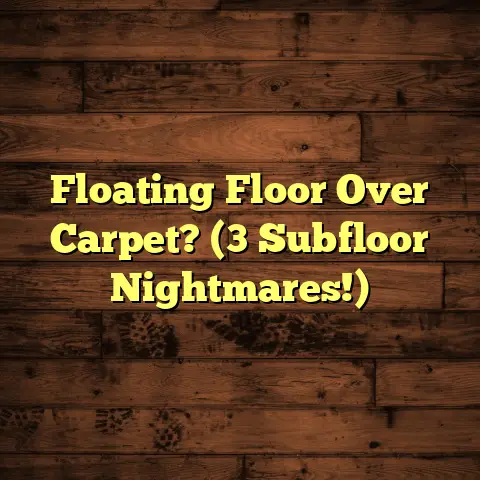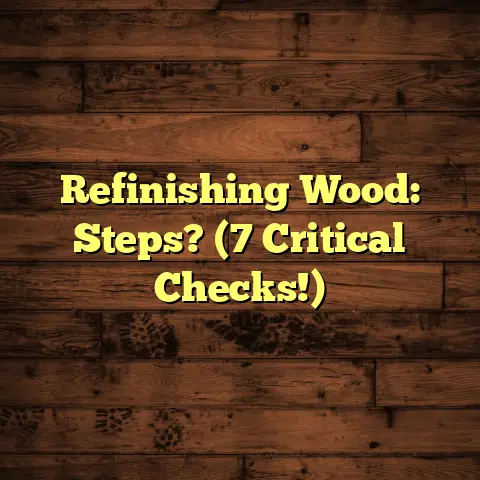Castile Soap on Concrete Floors? (2 Mistakes to Avoid!)
I’m excited to chat with you today about something that’s been buzzing in the industry: Castile soap and concrete floors.
But before we dive in, let’s take a moment to appreciate just how far cleaning tech has come, right?
It wasn’t too long ago that we were all sloshing around with harsh chemicals, holding our breath, and hoping for the best.
Now, we’re seeing this amazing shift towards eco-friendly products and a real awareness of sustainable living.
I’ve noticed more and more folks are looking for alternatives to those harsh chemicals.
That’s where Castile soap comes in. It’s been around for ages, but its versatility and effectiveness are making it a star again.
And concrete floors? They’re everywhere these days.
From sleek, modern homes to trendy commercial spaces, concrete is a popular choice.
It’s durable, looks fantastic, and when properly sealed, it’s relatively easy to maintain.
But here’s the thing: not all cleaning products play nice with concrete.
That’s why I wanted to share my insights on using Castile soap to keep those concrete floors looking their best.
I’ve seen some common mistakes that can actually do more harm than good.
So, let’s get into it, shall we? I’m going to walk you through everything you need to know about using Castile soap on concrete floors, and more importantly, help you dodge those pesky pitfalls.
Section 1: Understanding Castile Soap
Okay, first things first: what exactly is Castile soap?
Simply put, it’s a vegetable-based soap made traditionally from olive oil. The name “Castile” comes from the Castile region of Spain, where it originated.
Now, you might be thinking, “Soap is soap, right?”
Wrong! Castile soap is different. It’s biodegradable, super versatile, and surprisingly effective at cleaning all sorts of surfaces.
I’ve used it to clean everything from my kitchen counters to my dog, Buster!
Compared to traditional cleaning products, Castile soap is a breath of fresh air.
Most commercial cleaners are loaded with synthetic fragrances, dyes, and harsh chemicals that can irritate your skin and pollute the air.
Castile soap, on the other hand, is gentle and safe for both humans and pets.
I always recommend it to clients who have sensitivities or are just trying to create a healthier home environment.
Section 2: The Popularity of Concrete Floors
Now let’s talk concrete! Concrete flooring has really taken off in recent years, and for good reason.
It’s incredibly durable. I’ve seen concrete floors last for decades with minimal maintenance.
Plus, it has a unique aesthetic appeal. Whether you prefer a polished, industrial look or a more rustic, textured finish, concrete can be tailored to suit your style.
I think part of the appeal is that it’s so versatile.
You can stain it, stamp it, or even embed decorative elements like glass or stone.
In terms of maintenance, concrete is generally easy to care for.
Regular sweeping and occasional mopping are usually all it takes to keep it looking great.
However, I often hear from clients who are concerned about keeping their concrete floors clean and stain-free.
They want a solution that’s effective but also gentle and won’t damage the surface.
That’s where Castile soap comes back into the picture.
Section 3: The Benefits of Using Castile
Soap on Concrete Floors
So, can you actually use Castile soap on concrete floors?
The answer is a resounding YES!
When used correctly, Castile soap can be an excellent cleaner for concrete surfaces.
It’s effective at removing dirt, stains, and grime without stripping away sealants or damaging the floor.
I’ve found that it’s particularly good at lifting greasy messes in kitchens and bathrooms.
The key is to maintain the integrity and appearance of the concrete.
You don’t want to use anything too harsh that will etch the surface or leave behind a dull residue.
Castile soap cleans effectively without causing any damage.
I remember one client, Sarah, who had a beautiful polished concrete floor in her living room.
She tried a few different commercial cleaners, but they all left a streaky film.
I suggested she try diluted Castile soap, and she was amazed at the results.
Her floors were clean, shiny, and streak-free!
She even told me that she felt better knowing she was using a natural, non-toxic cleaner in her home.
Section 4: Mistake #1 – Not Diluting
Castile Soap Properly
Alright, let’s get down to the nitty-gritty.
The first mistake I see people make when using Castile soap on concrete floors is not diluting it properly.
I know, it seems simple, but trust me, it’s crucial.
Using undiluted Castile soap is a big no-no. It’s way too concentrated and can leave behind a sticky residue that’s difficult to remove.
Plus, it can make your floors slippery, which is definitely not what you want!
Why is dilution so important?
Well, Castile soap is a true soap, meaning it reacts with minerals in hard water to form soap scum.
When you use too much soap, especially without enough water, that soap scum can build up on your floors, leaving them looking dull and dingy.
So, how do you dilute Castile soap properly? Here’s my go-to method:
-
Gather your supplies: You’ll need a bucket, warm water, and your Castile soap. I prefer using Dr. Bronner’s, but any pure Castile soap will work.
-
Mix the solution: For general cleaning, I recommend using about ¼ cup of Castile soap per gallon of warm water.
If your floors are particularly dirty, you can increase the concentration slightly, but be careful not to overdo it.
-
Mix thoroughly: Use a mop or your hand to mix the solution until the soap is fully dissolved.
-
Mop your floors: Dip your mop into the solution, wring out the excess water, and mop your floors as usual.
-
Rinse (optional): If you’re concerned about residue, you can rinse your floors with clean water after mopping.
I usually skip this step unless I’ve used a slightly higher concentration of soap.
Here’s a handy table to keep in mind:
| Cleaning Task | Castile Soap to Water Ratio |
|---|---|
| General Floor Cleaning | ¼ cup per gallon |
| Heavily Soiled Floors | ⅓ cup per gallon |
| Light Cleaning | ⅛ cup per gallon |
Remember, less is more when it comes to Castile soap.
You can always add more soap if needed, but it’s much harder to remove excess soap once it’s on your floors.
Section 5: Mistake #2 – Neglecting to Test
on a Small Area First
Okay, now for the second mistake: failing to test Castile soap on a small, inconspicuous area of your concrete floor before full application.
I know, I know, it sounds like extra work, but trust me, it can save you a lot of headaches in the long run.
Why is a patch test so important?
Well, concrete floors can be finished and sealed in a variety of ways.
Some sealants are more sensitive to certain cleaning products than others.
You want to make sure that the Castile soap is compatible with your specific type of finish.
The last thing you want is to end up with a discolored or damaged floor!
I’ve seen it happen before, and it’s not pretty.
Here’s how to perform a patch test:
-
Choose an inconspicuous area: Pick a spot that’s hidden from view, like in a closet or underneath a rug.
-
Apply the diluted Castile soap: Use a clean cloth to apply a small amount of your diluted Castile soap solution to the area.
-
Let it sit: Allow the solution to sit on the surface for a few minutes.
-
Wipe it off: Use a clean, damp cloth to wipe away the solution.
-
Observe: Check the area for any signs of discoloration, etching, or other damage. Also, look for any residue or stickiness.
-
Wait 24 hours: Give the area 24 hours to fully dry and observe it again. Sometimes, reactions can take a little time to develop.
If everything looks good after 24 hours, then you can confidently use the Castile soap on the rest of your floor.
But if you notice any problems, stop immediately and consider using a different cleaning product.
It’s always better to be safe than sorry!
Section 6: Additional Tips for Cleaning
Concrete Floors with Castile Soap
Okay, so you know how to dilute Castile soap and why it’s important to do a patch test.
Now, let’s talk about some additional tips for cleaning concrete floors with Castile soap like a pro.
-
Use the right tools: I recommend using a microfiber mop for cleaning concrete floors.
Microfiber is super absorbent and does a great job of lifting dirt and grime.
Avoid using abrasive scrub brushes, as they can scratch the surface of your concrete.
-
Vacuum regularly: Before mopping, always vacuum your floors to remove any loose dirt, dust, and debris.
This will prevent you from just pushing the dirt around with your mop.
-
Spot clean spills immediately: The longer a spill sits on your concrete, the more likely it is to stain.
Blot up spills immediately with a clean cloth and then clean the area with your diluted Castile soap solution.
-
Consider adding essential oils: For a little extra cleaning power and a pleasant scent, you can add a few drops of essential oils to your Castile soap solution.
I like using lemon, lavender, or tea tree oil.
Just be sure to use pure, therapeutic-grade essential oils.
-
Re-seal your floors as needed: Over time, the sealant on your concrete floors can wear down, making them more susceptible to staining and damage.
I recommend re-sealing your floors every 1-2 years, depending on the amount of traffic they receive.
-
Frequency of cleaning: How often should you clean your concrete floors with Castile soap?
It really depends on your lifestyle and how much traffic your floors get.
For most homes, mopping once a week is usually sufficient.
But if you have kids or pets, you may need to mop more frequently.
-
Complementary Products: While Castile soap is great for general cleaning, you might want to consider using other products for specific tasks.
For example, a pH-neutral stone cleaner can be used for tougher stains or to give your floors an extra shine.
Conclusion
Alright, there you have it! Everything you need to know about using Castile soap on concrete floors.
I hope I’ve armed you with information to confidently tackle your next cleaning project.
Just remember to dilute your Castile soap properly and always test it on a small area first.
By avoiding these two common mistakes, you can keep your concrete floors looking beautiful for years to come.
I’m a big believer in using eco-friendly cleaning solutions whenever possible.
It’s not only better for your health and the environment, but it can also be just as effective as traditional cleaning products.
Castile soap is a perfect example of this.
So, give it a try! I think you’ll be pleasantly surprised at how well it works.
And please, share your experiences with me! I’d love to hear how Castile soap is working for you and if you have any other tips or tricks to share.
Happy cleaning, everyone!





